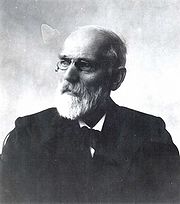Johannes Diderik van der Waals
| Johannes van der Waals | |
|---|---|
 |
|
| Born | 23 November 1837 Leiden, Netherlands |
| Died | 8 March 1923 (aged 85) Amsterdam, Netherlands |
| Nationality | Netherlands |
| Fields | Physics |
| Institutions | University of Amsterdam |
| Alma mater | University of Leiden |
| Doctoral advisor | Pieter Rijke |
| Doctoral students | Diederik Korteweg |
| Known for | Equation of state, intermolecular forces |
| Notable awards | Nobel Prize for Physics (1910) |
Johannes Diderik van der Waals (23 November 1837 – 8 March 1923) was a Dutch physicist and thermodynamicist famous for his work on an equation of state for gases and liquids.
Contents |
Biography
Early years
Van der Waals was born in Leiden, Netherlands, to Jacobus van der Waals and Elisabeth van den Burg. He became a school teacher, and later was allowed to study at the university, in spite of his lack of education in the field of classical languages. He studied from 1862 to 1865, earning degrees in mathematics and physics. He married Anna Magdalena Smit in 1864, and the couple had three daughters (Anne Madeleine, Jacqueline Elisabeth (poet), Johanna Diderica) and one son, the physicist Johannes Diderik, Jr. Van der Waals' nephew Peter van der Waals was a cabinet maker and a leading figure in the Sapperton, Gloucestershire school of the Arts and Crafts movement.
Career
In 1866, van der Waals became director of a secondary school in The Hague. He obtained a doctorate in Leiden in 1873 under Pieter Rijke, and in 1876 was appointed the first professor of physics at the newly established University of Amsterdam.
Van der Waals' doctoral thesis was entitled Over de Continuïteit van den Gas- en Vloeistoftoestand (On the continuity of the gas and liquid state). In this thesis he derived the equation of state bearing his name. This work gave a model in which the liquid and the gas phase of a substance merge into each other in a continuous manner. It shows that the two phases are of the same nature. In deriving his equation of state van der Waals assumed not only the existence of molecules (which in physics was disputed at the time), but also that they are of finite size and attract each other. Since he was one of the first to postulate an intermolecular force, however rudimentary, such a force is now sometimes called a van der Waals force.
A second great discovery of van der Waals was published in 1880: The Law of Corresponding States. This law shows, that after scaling temperature, pressure, and volume by their respective critical values, a general form of the equation of state is obtained which is applicable to all substances. This law served as a guide during the experiments that led to the liquefaction of helium by Heike Kamerlingh Onnes.
Van der Waals found his incentive for his life's work after reading the 1857 treatise by Rudolf Clausius entitled Über die Art der Bewegung welche wir Wärme nennen (On the Kind of Motion we Call Heat).[1] Van der Waals was later greatly influenced by the writings of James Clerk Maxwell, Ludwig Boltzmann, and Willard Gibbs. For his work, van der Waals won the 1910 Nobel Prize in physics.
Personal life
Van der Waals died in Amsterdam on 8 March 1923, one year after his daughter Jacqueline had died.
See also
- Van der Waals equation
- Van der Waals radius
- Van der Waals (crater)
References
- ↑ Van der Waals, Johannes, D. (1910). "The Equation of State for Gases and LiquidsPDF (588 KiB)." Nobel Lecture, December 12.
Further reading
- Kipnis, Aleksandr Yakovlevich; Boris Efimovich Yavelov, and John Shipley Rowlinson (July 1996). Van der Waals and Molecular Science. Oxford University Press. ISBN 0-19-855210-6.
External links
- Scientists of the Dutch School Van der Waals, Royal Netherlands Academy of Arts and Sciences
- Albert van Helden Johannes Diderik van der Waals 1837 – 1923 In: K. van Berkel, A. van Helden and L. Palm ed., A History of Science in the Netherlands. Survey, Themes and Reference (Leiden: Brill, 1999) 596 - 598.
- Johannes Diderik van der Waals - Biography at Nobelprize.org.
- Museum Boerhaave Negen Nederlandse NobelprijswinnaarsPDF (2.32 MiB)
- H.A.M. Snelders, Waals Sr., Johannes Diderik van der (1837-1923), in Biografisch Woordenboek van Nederland.
- Biography of Johannes Diderik van der Waals (1837 – 1923) at the National Library of the Netherlands.
|
||||||||||||||||||||